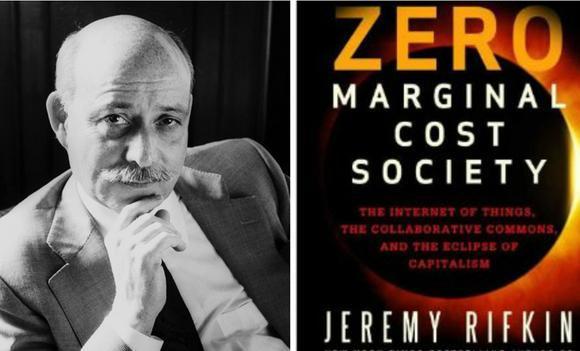New economic model is not just cutting costs
china.org.cn / chinagate.cn by Gao Liankui, December 5, 2014 Adjust font size:
|
Economic theorist and author Jeremy Rifkin and his latest book The Zero Marginal Cost Society |
While his "The Third Industrial Revolution" is still popular, another book authored by the American economist and social theorist Jeremy Rifkin, "The Zero Marginal Cost Society," has garnered worldwide attention.
Rifkin asserts that changes in production modes caused by the technological revolution will reduce the marginal costs of most products and services in our daily life to nearly zero.
It all sounds very encouraging, but we need to be wary of Rifkin's optimism. The "zero cost society" he describes refers to marginal cost, not real cost, while the world has entered an era of high living costs. Future economic development will not feature any growth, because cost reductions will shrink overall economic output, and for the first time, human society will probably face a situation in which economic development leads to a GDP decrease.
This future zero marginal cost society features the sharing of new energies (represented by wind and solar power) and new industrial technology (represented by 3D printing) along with the Internet and its growing number of products and services for daily life.
Green energies do not require concentrated production. They can be produced and marketed on their own. Free renewable energy derived from wind and sunlight have emerged in Europe, North America and India. Millions of people have converted their homes and offices into miniature power plants. Countless individuals and families have formed micro intelligent grid cooperatives.
According to the most optimistic forecast, the world will comprehensively enter an era of solar energy, i.e., an era when energy marginal cost will gradually drop to zero, in 2028. A free energy Internet is significant because it provides a human social production power source with endless space for sharing.
3D printing technology will completely change our life. Printing enterprises have not only been exempted from the restrictions of IPR protection, but have also significantly reduced their production costs. Nowadays, a "high-quality" 3D printer costs only US$1,500. Currently, around 100,000 amateurs in the world use 3D printing technology to turn out necessary products at nearly zero marginal cost.
In China, students at Beihang University use 3D printing technology to manufacture complex rocket and satellite parts. Another Chinese 3D printing company can construct 10 small houses within 24 hours by using cheap renewable materials at a per unit cost of under US$5,000. In addition, 3D printing has far-reaching impact on the durability, recyclability and pollution levels of sustainable production.


